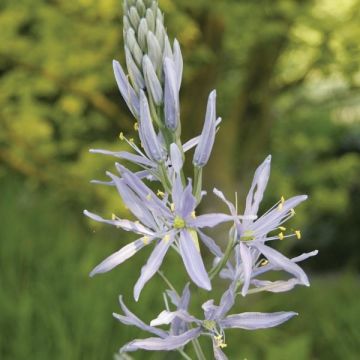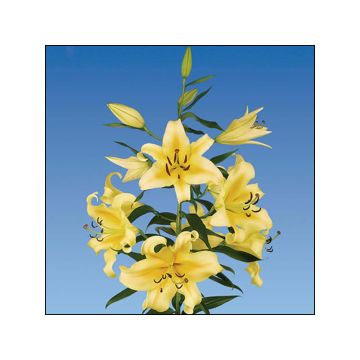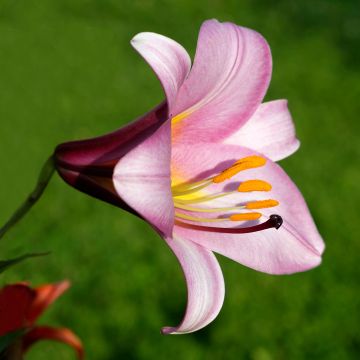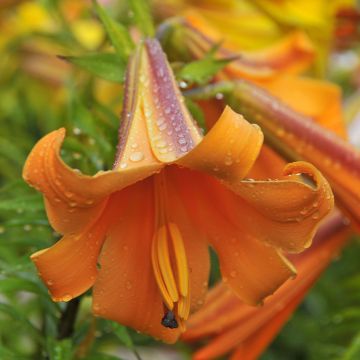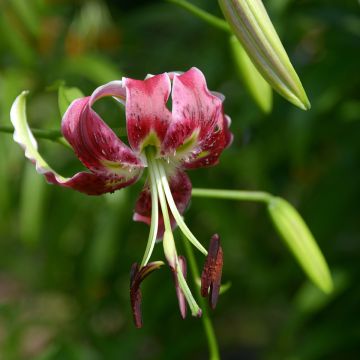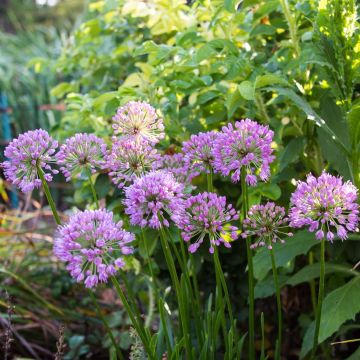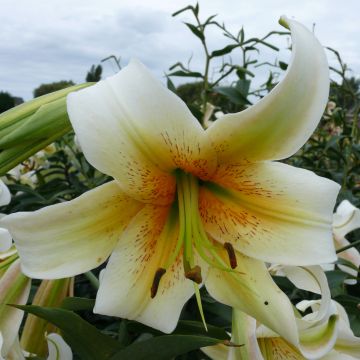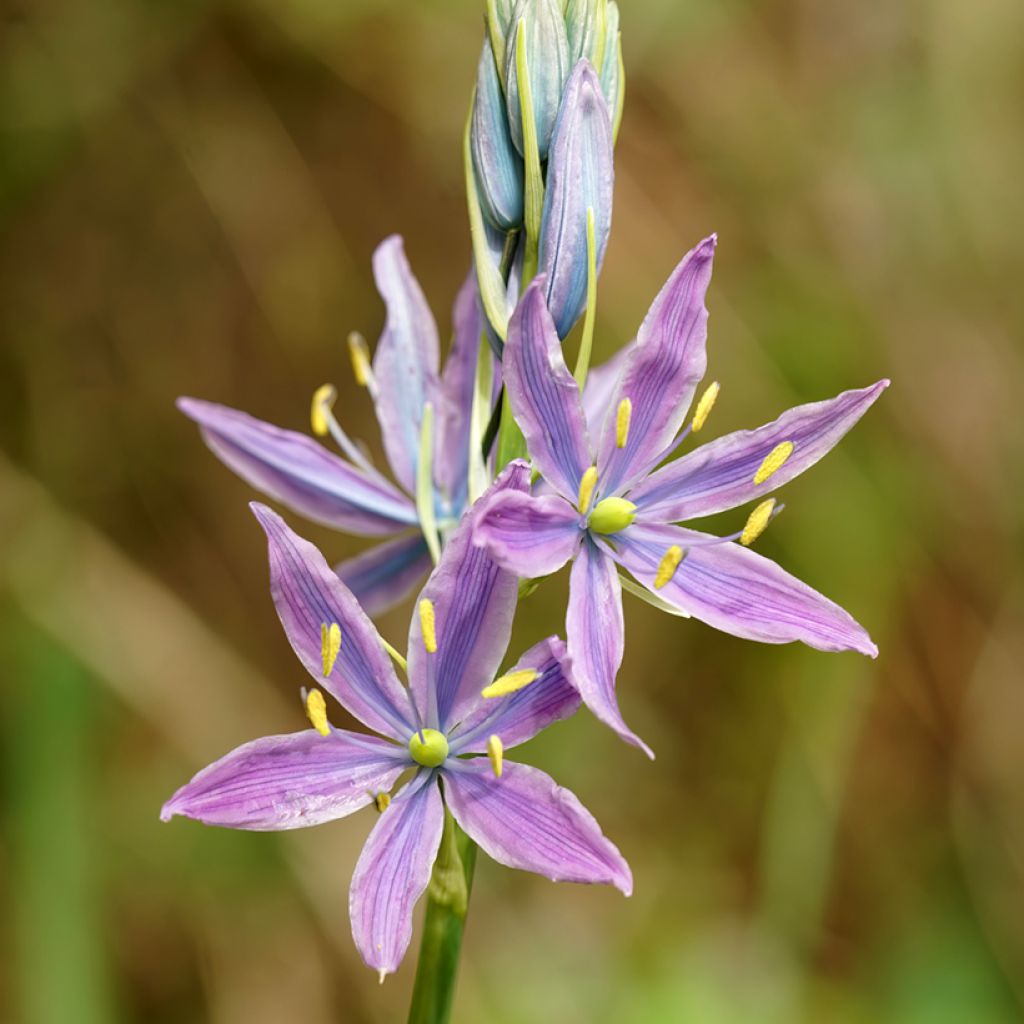

Camassia leichtlinii Aurora
Camassia leichtlinii Aurora
Camassia leichtlinii Aurora
Large Camas, Great Camas, Leichtlin's Camas
This plant carries a 6 months recovery warranty
More information
We guarantee the quality of our plants for a full growing cycle, and will replace at our expense any plant that fails to recover under normal climatic and planting conditions.
From €5.90 for pickup delivery and €6.90 for home delivery
Express home delivery from €8.90.
Does this plant fit my garden?
Set up your Plantfit profile →
Description
Camassia leichtlinii 'Aurora' is an attractive perennial bulbous plant with a bushy habit. This cultivar stands out with its charming mauve flowering. In May-June, the stems, which can reach up to 90 cm in height, are covered with star-shaped flowers in a light purple-pink shade, fading to a very pale pink, with a bluish band on the reverse. The centre of the flowers is bright green and the flower clusters are sprinkled with golden yellow anthers. The flowers of Camassia open from the bottom to the top.
Camassia, also known as Quamash, is now part of the Asparagaceae family, like asparagus. Native to Oregon in the northwest United States, the plant is very hardy. It can be found in flower beds, borders, rockeries, fields, and rocky gardens, as it is a plant that adapts easily. Camassia leichtlinii takes its name from Max Leichtlinn, a 19th-century German horticulturist specialising in bulbs. 'Aurora' is a cultivar that reaches a height of 70 to 90 cm in adulthood. Its linear leaves are bright green and measure from 20 to 60 cm long. They form a basal tuft from which the flower stems emerge. The large open star-shaped flower spikes, held on flower stems, measure from 10 to 30 cm long. They appear in May and June. The inflorescence opens from the bottom to the top. The 4 cm diameter flowers are composed of 6 petals that twist as they fade. Camassia is a vegetable plant that has an edible bulb, consumed by Native American tribes. These bulbs, however, are not appreciated by rodents, which allows the plant to be among the most resistant bulbous plants like daffodils.
Camassia leichtlinii 'Aurora', a plant of wet meadows in its natural habitat, can be grown in full sun or partial shade in wet to moist, fertile, and humus-bearing soil. It tolerates slightly heavy clay soils as long as attention is paid to drainage during winter. Planted with spring bulbs such as alliums, Fritillaries, or Tulips, it brings life to flower beds with its beautiful, large flowers. Its unsightly foliage after flowering can be hidden by perennials with foliage or later flowering, such as Hardy Geraniums in the sun or Hostas and Heucheras in partial shade. In cottage gardens, Delphiniums or bellflowers take over. You can also grow Camassia in containers on a terrace or balcony. Its flowers are beautiful in bouquets.
Report an error about the product description
Plant habit
Flowering
Foliage
Botanical data
Camassia
leichtlinii
Aurora
Asparagaceae (Liliaceae)
Large Camas, Great Camas, Leichtlin's Camas
Cultivar or hybrid
Other Camassia
Planting and care
Place Camassia leichtlinii Aurora in partial shade or full sun in fertile, humus-bearing, well-drained soil. It also tolerates heavy clay soils, provided that the soil drainage is improved so that the bulbs can survive the winter without any problems. Plant it in autumn at a depth of 10 cm and space the bulbs 20 cm apart. Water it regularly but not excessively to avoid the plant rotting due to stagnant moisture. Camassia naturalises very well when left undisturbed. Mulch in winter in regions with harsh winters. Once the flowers have faded, remove the flower stalks, leaving the stem. Remove the foliage when it turns yellow. The perennial returns each year with increasing vigour and more abundant inflorescences. Aphids and slugs may attack Camassia, but they cause very little damage as the plant is very robust.
Planting period
Intended location
Care
This item has not been reviewed yet - be the first to leave a review about it.
Spectacular bulbs
Haven't found what you were looking for?
Hardiness is the lowest winter temperature a plant can endure without suffering serious damage or even dying. However, hardiness is affected by location (a sheltered area, such as a patio), protection (winter cover) and soil type (hardiness is improved by well-drained soil).

Photo Sharing Terms & Conditions
In order to encourage gardeners to interact and share their experiences, Promesse de fleurs offers various media enabling content to be uploaded onto its Site - in particular via the ‘Photo sharing’ module.
The User agrees to refrain from:
- Posting any content that is illegal, prejudicial, insulting, racist, inciteful to hatred, revisionist, contrary to public decency, that infringes on privacy or on the privacy rights of third parties, in particular the publicity rights of persons and goods, intellectual property rights, or the right to privacy.
- Submitting content on behalf of a third party;
- Impersonate the identity of a third party and/or publish any personal information about a third party;
In general, the User undertakes to refrain from any unethical behaviour.
All Content (in particular text, comments, files, images, photos, videos, creative works, etc.), which may be subject to property or intellectual property rights, image or other private rights, shall remain the property of the User, subject to the limited rights granted by the terms of the licence granted by Promesse de fleurs as stated below. Users are at liberty to publish or not to publish such Content on the Site, notably via the ‘Photo Sharing’ facility, and accept that this Content shall be made public and freely accessible, notably on the Internet.
Users further acknowledge, undertake to have ,and guarantee that they hold all necessary rights and permissions to publish such material on the Site, in particular with regard to the legislation in force pertaining to any privacy, property, intellectual property, image, or contractual rights, or rights of any other nature. By publishing such Content on the Site, Users acknowledge accepting full liability as publishers of the Content within the meaning of the law, and grant Promesse de fleurs, free of charge, an inclusive, worldwide licence for the said Content for the entire duration of its publication, including all reproduction, representation, up/downloading, displaying, performing, transmission, and storage rights.
Users also grant permission for their name to be linked to the Content and accept that this link may not always be made available.
By engaging in posting material, Users consent to their Content becoming automatically accessible on the Internet, in particular on other sites and/or blogs and/or web pages of the Promesse de fleurs site, including in particular social pages and the Promesse de fleurs catalogue.
Users may secure the removal of entrusted content free of charge by issuing a simple request via our contact form.
The flowering period indicated on our website applies to countries and regions located in USDA zone 8 (France, the United Kingdom, Ireland, the Netherlands, etc.)
It will vary according to where you live:
- In zones 9 to 10 (Italy, Spain, Greece, etc.), flowering will occur about 2 to 4 weeks earlier.
- In zones 6 to 7 (Germany, Poland, Slovenia, and lower mountainous regions), flowering will be delayed by 2 to 3 weeks.
- In zone 5 (Central Europe, Scandinavia), blooming will be delayed by 3 to 5 weeks.
In temperate climates, pruning of spring-flowering shrubs (forsythia, spireas, etc.) should be done just after flowering.
Pruning of summer-flowering shrubs (Indian Lilac, Perovskia, etc.) can be done in winter or spring.
In cold regions as well as with frost-sensitive plants, avoid pruning too early when severe frosts may still occur.
The planting period indicated on our website applies to countries and regions located in USDA zone 8 (France, United Kingdom, Ireland, Netherlands).
It will vary according to where you live:
- In Mediterranean zones (Marseille, Madrid, Milan, etc.), autumn and winter are the best planting periods.
- In continental zones (Strasbourg, Munich, Vienna, etc.), delay planting by 2 to 3 weeks in spring and bring it forward by 2 to 4 weeks in autumn.
- In mountainous regions (the Alps, Pyrenees, Carpathians, etc.), it is best to plant in late spring (May-June) or late summer (August-September).
The harvesting period indicated on our website applies to countries and regions in USDA zone 8 (France, England, Ireland, the Netherlands).
In colder areas (Scandinavia, Poland, Austria...) fruit and vegetable harvests are likely to be delayed by 3-4 weeks.
In warmer areas (Italy, Spain, Greece, etc.), harvesting will probably take place earlier, depending on weather conditions.
The sowing periods indicated on our website apply to countries and regions within USDA Zone 8 (France, UK, Ireland, Netherlands).
In colder areas (Scandinavia, Poland, Austria...), delay any outdoor sowing by 3-4 weeks, or sow under glass.
In warmer climes (Italy, Spain, Greece, etc.), bring outdoor sowing forward by a few weeks.

































